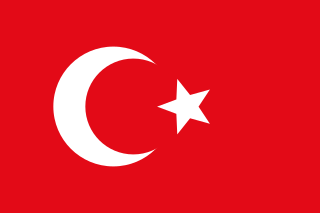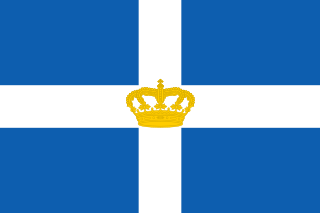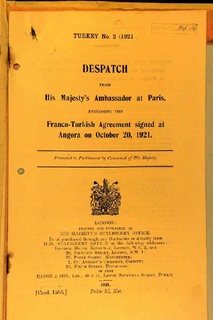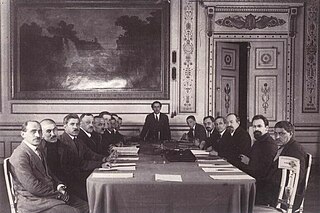 W
WThe Battle of Kütahya–Eskişehir, was fought between July 10 and July 24, 1921 when the Greek Army of Asia Minor defeated the Turkish troops commanded by İsmet Pasha in defence of the line of Kara Hisâr-ı Sahib -Kütahya-Eskişehir.
 W
WThe Battle of Sakarya, also known as the Battle of the Sangarios, was an important engagement in the Greco-Turkish War (1919–1922), the western front of the Turkish War of Independence.
 W
WThe Constitution of 1921 was the fundamental law of Turkey for a brief period from 1921 to 1924. The first constitution of the modern Turkish state, it was ratified by the Grand National Assembly of Turkey in January 1921. It was a simple document consisting of only 23 short articles. In October 1923 the constitution was amended to declare Turkey to be a republic. In April the following year the constitution was replaced by an entirely new document, the Constitution of 1924.
 W
WThe Franco–Turkish War, known as the Cilicia Campaign in France and as the Southern Front of the Turkish War of Independence in Turkey, was a series of conflicts fought between France and the Turkish National Forces from December 1918 to October 1921 in the aftermath of World War I. French interest in the region resulted from the Sykes-Picot Agreement and returning Armenian refugees of the Armenian Genocide back to their homes.
 W
WThe Government of the Grand National Assembly, commonly known as the Ankara Government, was the name given to the provisional and revolutionary Turkish government based in Ankara during the Turkish War of Independence (1919–1923) and during the final years of the Ottoman Empire. It was led by the Turkish National Movement, as opposed to the crumbling Constantinople Government, which was led by the Ottoman Sultan.
 W
WThe Greco-Turkish War of 1919–1922 was fought between Greece and the Turkish National Movement during the partitioning of the Ottoman Empire in the aftermath of World War I, between May 1919 and October 1922.
 W
WThe İzmit massacres refer to atrocities committed in the region of İzmit, Turkey, during the Greco-Turkish War (1919-1922) which took place during the Greek Genocide. An Inter-Allied Commission of Enquiry that investigated the incidents, submitted a report, on 1 June 1921, about the events. In general it accepted the Greek claims that Turkish troops massacred more than 12,000 local civilians, while 2,500 were missing and stated that the atrocities committed by the Turks in the Izmit peninsula "have been more considerable and ferocious than those on the part of the Greeks".
 W
WThe occupation of Constantinople, the capital of the Ottoman Empire, by British, French, Italian, Greek forces, took place in accordance with the Armistice of Mudros, which ended Ottoman participation in the First World War. The first French troops entered the city on November 12, 1918, followed by British troops the next day. The Italian troops landed in Galata on February 7, 1919.
 W
WThe occupation of Smyrna was the military control by Greek forces of the city of Smyrna and surrounding areas from 15 May 1919 until 9 September 1922. The Allied Powers authorized the occupation and creation of the Zone of Smyrna during negotiations regarding the partition of the Ottoman Empire to protect the ethnic Greek population living in and around the city. The Greek landing on 15 May 1919 was celebrated by the substantial local Greek population but quickly resulted in ethnic violence in the area. This violence decreased international support for the occupation and led to a rise of Turkish nationalism. The High Commissioner of Smyrna, Aristeidis Stergiadis, took a firm stance against discrimination against the Turkish population by the administration; however, ethnic tensions and discrimination remained. Stergiadis also began work on projects involving resettlement of Greek refugees, the foundations for a University, and some public health projects. Smyrna was a major base of operations for Greek troops in Anatolia during the Greco-Turkish War (1919–1922).
 W
WRüsumat No. 4 was a former Turkish trawler, which is known for her activities during the Turkish War of Independence.
 W
WThe Ankara Agreement (1921) was signed on 20 October 1921 at Ankara between France and the Grand National Assembly of Turkey, ending the Franco-Turkish War.
 W
WThe Treaty of Kars was a treaty that established the borders between Turkey and the three Transcaucasian republics of the Soviet Union, which are now the independent republics of Armenia, Georgia and Azerbaijan. The treaty was signed in the city of Kars on 13 October 1921.
 W
WThe Treaty of Moscow, or Treaty of Brotherhood was an agreement between the Grand National Assembly of Turkey (TBMM), under the leadership of Mustafa Kemal Atatürk, and Russia, under the leadership of Vladimir Lenin, signed on 16 March 1921. Neither the Republic of Turkey nor the Soviet Union had then been established. The internationally-recognised Turkish government at the time was that of Sultan Mehmed VI, but it was not party to the Treaty of Moscow. The Sultan's government had signed the Treaty of Sèvres, which had been repudiated by the Turkish National Movement.
 W
WThe Turkish War of Independence was fought between the Turkish National Movement and the Allied powers—namely Greece in the West, Armenia on the East, France on the South, royalists and the separatists in various cities, and the United Kingdom and Italy in Constantinople —after parts of the Ottoman Empire were occupied and partitioned following the Ottomans' defeat in World War I.
 W
WThe Yalova Peninsula massacres were a series of massacres and ethnic cleansings during 1920–1921, the majority of which occurred during March – May 1921. They were committed by local Greek and Armenian gangs and the invading Hellenic Army against the Turkish Muslim population of the Yalova Peninsula. There were 27 villages burned and in Armutlu. According to journalist Arnold J. Toynbee c. 300 Muslims were killed during April–July 1921. In an Ottoman inquiry of 177 survivors in Constantinople, the number of victims reported was very low (35), which is in line with Toynbee's descriptions that villagers fled after one to two murders. Moreover, approximately 1,500 out of 7,000 Muslims remained in the region after the events or 6,000 had left Yalova where 16 villages had been burned. On the other hand, Ottoman and Turkish documents on massacres claim that at least 9,100 Muslim Turks were killed.